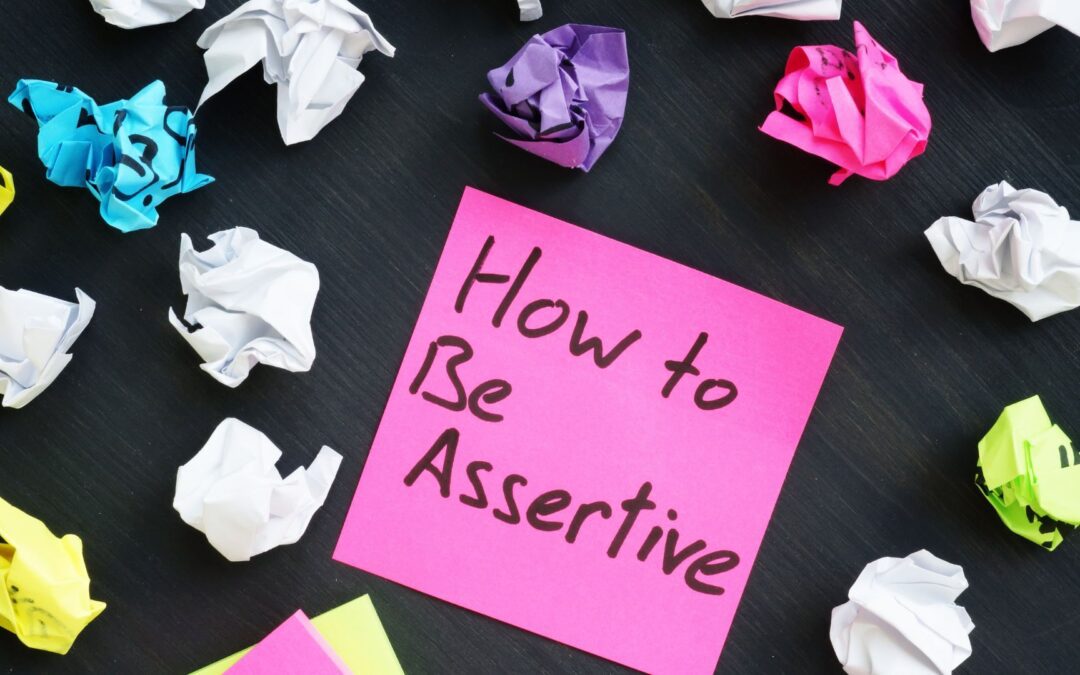In this post I focus on the topic of assertiveness. What it is, why it’s important and how you can develop your skills it in.
The key reason preventing many women from communicating directly with others is fear. Fear of conflict, of being rejected, of looking foolish, fear of failure. Yet by not tackling your fears, you’re restricting your ability to experience life to the full. Not dealing with situations or people who are causing you problems or making you feel distressed or angry means you suppress your feelings. You may then either bottle them up or express them inappropriately. You can end up short-changing yourself, finding your needs aren’t being met.
A definition of assertiveness
Assertiveness is the ability to express yourself clearly and respectfully. It’s the balance between standing up for your values and rights, while considering others’ feelings and perspectives.
Assertiveness is not a state of being; it’s a choice of behaviour. There will be a right time and place to decide when to behave assertively.
Assertiveness sits between Passivity and Aggression on a spectrum and you’ll move back and forth along the spectrum each day.
Why behaving assertively can be a challenge
Many women can find direct, open and honest communication uncomfortable or scary. Women have been stereotypically socialised to become peace-makers and resolvers of conflict. Women who are assertive may be labelled as ‘aggressive’ as opposed to men who may be described as ‘direct.’
Opening yourself up to express honestly how you feel and what you want requires a degree of vulnerability. Our reptilian brains aren’t always helpful in these instances. Instinctively our amygdala seeks to protect us from danger. Which would be fine if we were facing a genuine ‘fight or flight’ response from physical danger from a woolly mammoth. But that’s unlikely; in most cases it’s more likely to be our body’s response to a perceived psychological threat. However, we are the one species which has the ability to press ‘pause’ before we respond to a situation. This ability to pause enables us to consider what we want the outcome of a situation to be, before we take action.
Pausing may mean initially giving yourself some distance from the situation in order to consider how you choose to respond to it. This will give you time to consider what you want the outcome to be. A gap between a situation and your response to it can help to remove some of the emotion, making it easier to approach it more calmly. It will also make you more receptive to the other person’s perspective as you’ll be able to listen better.
It’s all about context
Assertiveness is contextual. Some women will find some situations straightforward but struggle with others. And you remain a work in progress as far as assertiveness is concerned. There will always be a new scenario that will take you out of your comfort zone.
However, regularly practising your assertiveness skills will enable you to use them in more challenging situations. Becoming proficient in and willing to behave assertively will, over time, enable you to be more truly yourself. Others will understand you better when your communication is more direct and honest. And you will reap the benefits of becoming more comfortable expressing yourself, stating what you want and need as well as more empathic and a better listener. What’s not to like?
Assertiveness: The key ingredients
Listen
The skill of active listening is key to effective assertive communication. This can be hard. You may be hearing things which are making you feel anxious or with which you disagree. The other person may be upset or expressing strong feelings. Try and give the other person your full attention.
There may not however have been a conversation. Perhaps you’re responding to an action that’s recently taken place which has impacted you. In this case, give some thought to the context of the action in an attempt to understand why it may have happened.
Demonstrate your understanding
It’s important to put yourself in the other person’s shoes. Before you have a conversation, reflect on what you’ve heard or experienced; consider how they may be feeling and be open to hearing their perspective. Your boss, for example, may be uncharacteristically stressed. Perhaps they are under pressure from their boss.
Say what you think and feel
It’s important to own your thoughts and feelings. So not “you’ve really upset me” but “when you were critical of my work, I felt really upset.” Separate the behaviour from the person.
Say what you want to happen
Be clear what it is you want. Focus on asking for a change in the person’s behaviour not their personality. “In future, I’d like you to share your concerns about my performance with me in private, not in front of my colleagues“, as opposed to “you’ve humiliated me in front of the whole team.”
Work out joint solutions and the consequences
A gap between what you and the other person wants requires a joint discussion and solution which pleases both parties. That’s not the same as a compromise. Reaching agreement will be far more likely if all of the assertiveness ingredients have been used.
Will being assertive guarantee success?
Not necessarily. However, by stating how you feel and what you want to happen you’ll have made your feelings about what happened clear to the other person. You’ll have been true to yourself in doing so and in attempting to explore a way forward.
By choosing to behave assertively more routinely, others will come to respect your personal and professional boundaries.
And, as I said to the group of women I was working with on the subject- “What’s a better alternative?”
Assertiveness is your ability to act in harmony with your self-esteem without hurting others.”
Author Unknown


